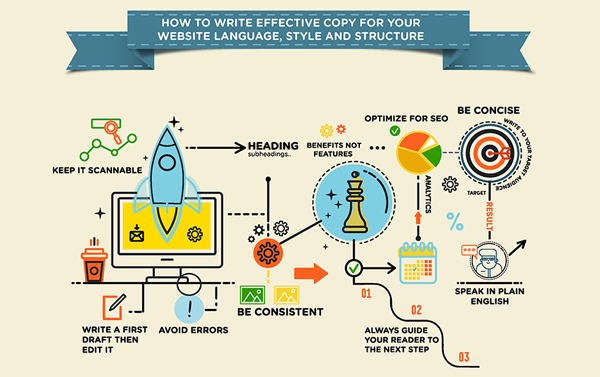If you can write, you can write great web copy, right? Wrong. Why? Because web copy is unique. Not only do people read online copy differently to printed text, but web copy must also be powerful enough to engage, persuade and drive action before people click away. It’s a tough challenge for even the most experienced copywriter, so what’s the key to success?
In this two part blog, we’ll provide some detailed advice on getting your web copy right. First up, here are our recommended best practices for crafting effective web copy.

Keep it Scannable
People don’t read web copy word for word, they scan. They want information fast and they don’t want to dig deep to find it. Whilst blocks of text may work in other forms of written content, on the web the more digestible the better. Section copy with headings and subheads; use bullet points; stick to a maximum of four lines and one idea per paragraph; and keep sentences simple.
Make Headings and Subheads Meaningful
What stands out most on a webpage other than visuals? Headings. That is why you need to craft them wisely. This isn’t the place to be vague or ambiguous. The best headings and subheads are descriptive and meaningful. They should clearly spell out what is on the web page, focusing on USPs, benefits and key information.
Be Concise
Keep your web copy tight. Ensure every sentence has a clear purpose, don’t say more than you need to and avoid repetition. Remove any marketing fluff including hollow superlatives such as ‘excellent’, ‘remarkable’ or ‘matchless’. And avoid overuse of adjectives and adverbs. When you do use them, make sure they’re based in fact, for example, don’t say you are world-leading if you’re not.
Get to the Point
Because people scan, your copy needs to start with the most important bits of information first. So if they only read a couple of lines, they’ll still get the main message. This type of writing is known as inverted pyramid style. It’s a technique commonly employed by journalists where they summarise first, follow with the most important supporting information and end with the background.
Benefits Not Features
A big mistake people often make when writing web copy is focusing on defining the features of their product or service – explaining what it is and how it works. But the truth is, potential customers aren’t interested in features, they want to know how these features benefit them. Because of this, your copy should be emotive not descriptive, focusing on addressing needs, values and concerns.
Speak in Plain English
Forget jargon or tech-speak. You won’t impress anyone, but you will scare off potential customers who may not understand what you’re talking about. Likewise, don’t try to create a great literary masterpiece. Whilst there is nothing wrong with a little creativity, in fact it is encouraged, ensure you write clearly and simply in plain English – you’ll get the message across much more effectively.
Write to Your Target Audience
Don’t write your website copy for a generic audience. Instead, tailor you copy so that it speaks directly to your customers or clients – one-on-one. You can achieve this by writing in the second person i.e. using ‘you’ instead of ‘they’. In addition, apply a tone of voice that speaks their language, be it conversational and chatty or friendly but professional.
Always Guide Your Reader to the Next Step
The main purpose of a website is to push prospects further along the buying funnel. Therefore it’s important that you always craft your copy with this in mind. After you’ve drawn them in with great headings and enticing benefits, don’t leave them hanging. Make sure you tell them exactly what they should do next, whether that’s go to another page, fill in a contact form or place an order.
Be Consistent
Whether it’s your sentence casing, the fonts you use or the tone of voice you employ, make sure you set a standard and apply it consistently. For example, don’t have one page with headings written in sentence case and another with headings in title case. Similarly, don’t be chatty on one page and formal on the next. These may seem like little things, but inconsistency spells unprofessionalism.
Avoid Errors
Nothing damages your credibility like copy and content errors so avoid them at all costs. This includes spelling and grammar mistakes, typographical slips and factual inaccuracies. If you can’t even get your web copy right, what kind of a message does this send to potential customers? Not a good one. In addition, some types of factual errors can have legal implications.
Write a First Draft then Edit it
Once you have written your web copy don’t just immediately upload it. Make sure you step back for a few hours then go back and edit it. Correct language errors, cut unnecessary words and reconsider if meanings are clear. Think what tweaks would make it more engaging, more credible and more persuasive. In addition, edit it again once it’s on screen as it can read very differently.
Optimize for SEO
Why is this one last? Because if you’re writing good quality web copy and following these rules, you should automatically be pleasing the Google Gods. Your long-tail keywords should appear naturally, your copy should be devoid of errors and your pages should be easy for web spiders to index. As a result, increased visibility in search should be par for the course.
Now you know what it takes to write effective web copy, the next step is getting the content right. Want to know what pages you should include on your site and what to include on each? Look out for How to Write Effective Copy for Your Website: Part 2 later in the week.